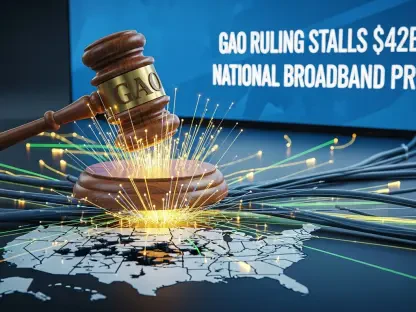Imagine a nation of over a billion people, where seamless connectivity is no longer a luxury but a necessity for daily life, from remote working to digital payments, shaping how individuals and businesses thrive. In this landscape, Vodafone Idea (Vi), India’s third-largest telecom operator, has rolled out 5G services across 17 cities while simultaneously enhancing its 4G network to cover 84% of the population. This dual strategy has sparked intense discussion among industry observers, technology analysts, and market watchers. This roundup dives into diverse perspectives on Vi’s network transformation, exploring opinions and tips from various sources to assess how this move shapes the competitive telecom market in India and what it means for consumers and stakeholders.
Unpacking Diverse Views on Network Growth
5G Rollout in 17 Cities: Progress or Catch-Up?
The deployment of 5G services in 17 major urban centers, including Mumbai, Delhi-NCR, and Bengaluru, has been hailed by some industry watchers as a significant milestone for Vi. Many note the technological edge brought by partnerships with global leaders like Ericsson, leveraging non-standalone 5G architecture for faster deployment. This approach is seen as a smart step to ensure reliable service in densely populated areas where data demand is skyrocketing.
However, not all opinions align on the impact of this rollout. A segment of market analysts argues that Vi’s coverage remains limited compared to competitors who have already established broader 5G footprints. They suggest that while the focus on priority telecom circles is strategic, the phased expansion might struggle to meet consumer expectations for rapid nationwide access, raising questions about Vi’s ability to close the gap.
Another perspective emphasizes the role of advanced tools like AI-driven network optimization in this rollout. Some technology consultants highlight how such innovations improve efficiency and reduce downtime, positioning Vi to deliver a high-quality user experience despite a smaller initial reach. This viewpoint underscores a belief that quality could outweigh quantity in the early stages of 5G adoption.
Late 5G Entry: Strategic Advantage or Risky Delay?
Vi’s delayed entry into the 5G race has drawn mixed reactions from industry voices. Several telecom strategists commend the decision to adopt cost-effective solutions like Disaggregated Radio Access Network (RAN) systems, which lower operational expenses and enhance scalability. They argue that this late start allowed Vi to learn from early movers’ challenges, potentially building a more sustainable network.
On the flip side, a different group of analysts warns that being behind in 5G deployment could erode market share in a sector where speed to market often dictates consumer loyalty. They point out that while cost savings are beneficial, the risk of appearing outdated to tech-savvy users might outweigh the financial gains if competitors continue to expand aggressively.
A third opinion focuses on the long-term benefits of this approach, with some industry observers suggesting that Vi’s emphasis on efficiency over haste could set a precedent for other operators. They advocate for patience, noting that a well-planned infrastructure might prove more resilient as data demands grow over the coming years, potentially turning a perceived weakness into a competitive strength.
4G Enhancements: Backbone of Connectivity
Turning to 4G upgrades, many industry insiders praise Vi’s efforts to expand coverage to 84% of India’s population, with a 35% increase in data capacity since earlier benchmarks. They argue that this focus ensures reliable internet access for rural and semi-urban areas, where 5G remains impractical due to cost and infrastructure constraints. This strategy is seen as a pragmatic way to address immediate needs.
Conversely, a smaller but vocal group of commentators questions whether prioritizing 4G might divert resources from faster 5G scaling. They contend that while 4G is crucial for widespread access, overemphasis on legacy networks could hinder Vi’s positioning as a forward-thinking player in a market increasingly defined by next-generation technology.
An additional angle comes from consumer advocacy groups, who emphasize the tangible benefits of enhanced 4G speeds and reach across 17 telecom circles. Their perspective is that for millions of users, especially in less urbanized regions, these upgrades translate directly into better video streaming, smoother online transactions, and improved communication, making 4G the true lifeline of connectivity today.
Balancing 5G Innovation with 4G Stability
The challenge of integrating cutting-edge 5G with robust 4G infrastructure has elicited varied insights from telecom experts. A common view is that Vi’s dual-network strategy mirrors a global trend in emerging markets, where diverse consumer needs demand a blend of innovation and reliability. This balance is often cited as essential for maintaining customer satisfaction across different demographics.
Differing opinions emerge on the execution of this balance, with some market watchers cautioning that splitting focus between two technologies could strain resources and slow overall progress. They argue that a more concentrated push toward 5G might yield faster brand recognition as a tech leader, even if it means temporarily neglecting broader 4G coverage goals.
Yet another take stresses the importance of adaptability, with certain industry consultants recommending that telecom operators like Vi continuously reassess their dual strategies based on real-time user data and regional demand. This flexible mindset, they suggest, could help navigate the complexities of a market where urban hubs crave 5G while rural areas still rely heavily on 4G, ensuring no segment is left behind.
Key Takeaways from Industry Perspectives
Beyond the specifics of 5G and 4G, broader insights emerge from various sources on how telecom operators can thrive in competitive environments. A recurring tip is the importance of investing in cost-efficient technologies, as seen in Vi’s adoption of advanced systems that reduce deployment expenses. This approach is frequently highlighted as a model for balancing innovation with fiscal responsibility.
Another piece of advice centers on the value of phased rollouts tailored to priority regions, a tactic many analysts believe helps manage risks while building consumer trust. This perspective encourages operators to focus on quality delivery in select areas before scaling, a strategy that could resonate with stakeholders looking for steady, measurable growth.
Lastly, a consensus forms around the need for dual-network prioritization, with numerous voices advocating for sustained investment in both current and future-ready infrastructure. For consumers, this translates into a promise of faster, more reliable internet over time, while for industry players, it offers a blueprint for navigating the delicate balance between immediate impact and long-term vision.
Reflecting on the Broader Impact
Looking back, the discussions surrounding Vodafone Idea’s network expansion paint a vivid picture of an industry at a crossroads, grappling with the dual demands of innovation and accessibility. The insights gathered from diverse sources underscore a shared recognition of the complexities involved in rolling out 5G while maintaining robust 4G services. For stakeholders and consumers alike, the debates offer valuable clarity on how strategic delays, technological advancements, and regional focus shape connectivity outcomes. Moving forward, a practical next step lies in closely monitoring how such balanced approaches evolve, with an eye toward adopting scalable solutions that prioritize user needs. Exploring case studies of other global telecom markets could also provide fresh ideas, ensuring that the lessons learned continue to inform smarter, more inclusive network strategies.









